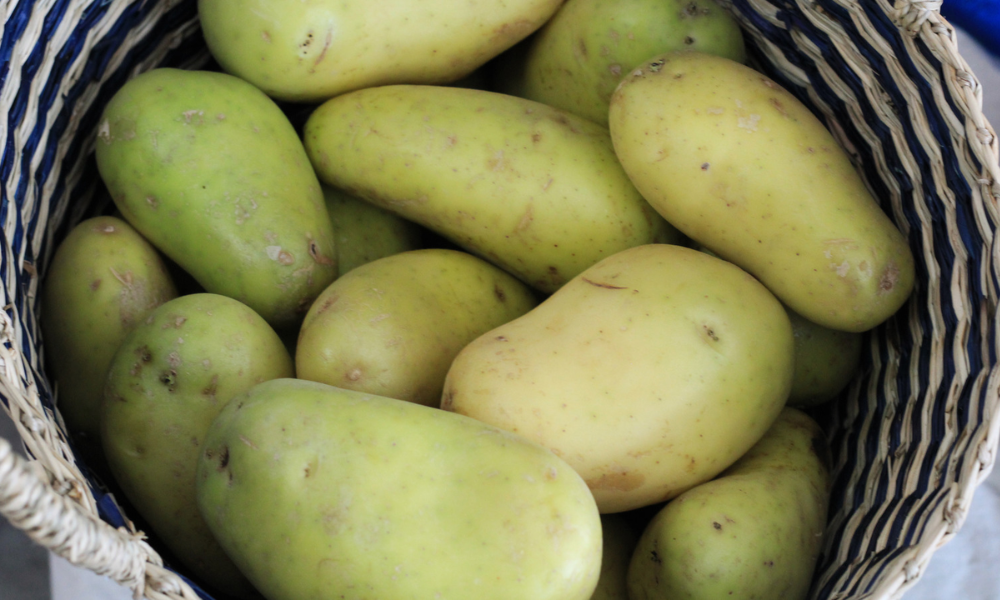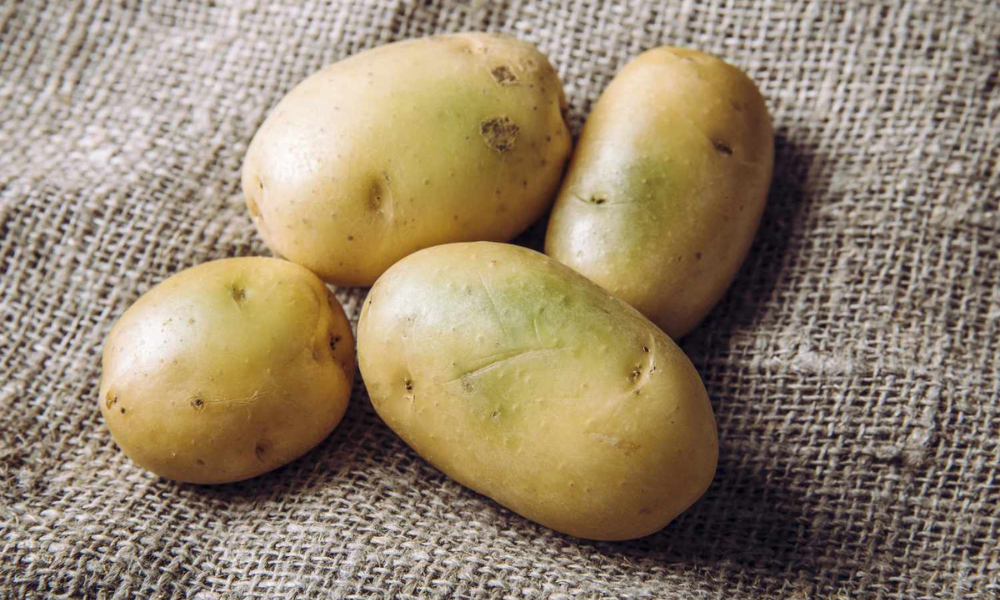Potatoes are a staple food in many cultures worldwide, but did you know they can be toxic if they turn green? The presence of solanine, a naturally occurring toxin that can cause a variety of symptoms when consumed in large quantities, causes the green color in potatoes.
You need to know the facts if you want to eat a green potato or if it is safe to eat green potatoes. Consuming green potatoes is unsafe, and you may have a negative experience. Furthermore, there are ways to avoid having a bad experience. This article will discuss the risks of eating green potatoes, as well as steps you can take to avoid solanine and ensure your potatoes are safe to eat.
Is it Safe to Eat Green Potatoes?
Green potatoes should be avoided because they contain solanine, a naturally occurring toxin that can cause stomach upset, nausea, and headaches if consumed in large quantities. Solanine is abundant in green potato parts, skin, eyes, and sprouted potatoes.
When potatoes are exposed to light, they produce chlorophyll, which turns them green, and the level of solanine rises along with it. Green potatoes should be discarded; however, if only a small portion is green, it is best to cut away the green parts before eating the rest.
To keep potatoes from turning green, store them in a cool, dark place, and always inspect potatoes for green spots before using them. If you’re unsure whether a potato is safe to eat, err on caution and discard it.
As always, symptoms of solanine toxicity may vary depending on the individual and the amount of solanine consumed; if you experience symptoms after eating green potatoes, please seek medical attention.
How do you Remove Solanine from Potatoes?
Cooked potatoes cannot Turn Green nor Produce Solanine
Green potatoes may appear to be a harmless way to consume vegetables. But solanine is a toxin that may be harmful to you, especially if you’re a child.
Solanine is a glycoalkaloid that occurs naturally in potatoes. It’s a substance that protects potatoes from insects and is also a pesticide. Solanine is toxic to humans and can cause headaches, vomiting, and diarrhea.
The most common cause of solanine poisoning in humans is potatoes. But solanine can also be found in tomatoes and eggplants. The best way to prevent this is to avoid eating green potatoes.
The first step is to check the potatoes for green coloring. If they have green spots or discoloration, remove them. This will also help to cut down on solanine, which is found in potato peels.
Secondly, you’ll want to ensure that the potatoes you buy are stored in a dark and cool place. The best place to store potatoes is in a cool, dark basement. The average kitchen is too warm for long-term storage.
Reference: EXTRACTION OF -SOLANINEAND -CHACONINE FROM GREEN POTATO TUBERS AND EVALUATION OF ITS ANTIMICROBIAL ACTIVITY
Why do Potatoes Turn Green?
When potatoes are exposed to light, they turn green. The pigment that gives plants their green color, chlorophyll, is produced by the potato in response to light. When potatoes are exposed to light, their level of solanine, a naturally occurring toxin, rises along with their chlorophyll content.
To cultivate potatoes, they are normally planted underground, away from light. However, they are typically hauled to the surface and exposed to light when harvested. To protect them from light, potatoes are often covered with dirt or other materials while being stored.
When a potato begins to sprout, which starts to develop anew, it exposes itself to light and creates chlorophyll. This is another reason why potatoes turn green.
How to Prevent Potatoes from Turning Green?
Here are a few methods for keeping potatoes from turning green:
Store potatoes in a cool, dark place: Put potatoes in a brown paper bag and store them in a cool, dark place. Potatoes should be stored in a cool, dark location between 45-50 degrees Fahrenheit (7-10 degrees Celsius), such as in a pantry or root cellar. This will keep the potatoes from turning green from being exposed to light.
Keep potatoes in a brown paper bag: Putting potatoes in a brown paper bag and storing them in a cool, dark place can help absorb any light they may be exposed to, preventing them from turning green.
Before storing potatoes, please do not wash them: Washing potatoes before storing them can remove the protective layer on the skin, causing them to turn green.
Remove sprouts before storing: If you notice the potato has sprouted, it has begun to grow again, and you should remove the sprouts before storing them to prevent the potato from turning green.
Purchase potatoes with minimal greening: When purchasing potatoes, look for any green spots or discoloration and avoid purchasing potatoes with excessive greening.
Keep an eye on your potatoes: Because potatoes can turn green quickly, check them frequently and discard any that have turned green.
Is Peeling or Boiling Green Potatoes Effective?
Green potatoes can be peeled to remove some of the solanine, a naturally occurring toxin found in the green parts of potatoes, but not all of it. Solanine is concentrated not only in the potato’s green parts but also in the surrounding area. As a result, even after peeling, the potato may still have high levels of solanine.
Boiling green potatoes may also be ineffective in removing solanine because solanine is not water-soluble and thus cannot be removed through cooking. Furthermore, because solanine is a heat-stable alkaloid, boiling green potatoes does not necessarily reduce the solanine content.
For these reasons, it is not advisable to eat green potatoes since they contain solanine, a naturally occurring toxin that, when ingested in large doses, can result in symptoms including nausea, headaches, and upset stomach. Throwing away potatoes that have gone green is the greatest method to avoid exposure to solanine. Additionally, if you are having symptoms after ingesting green potatoes, it is always a good idea to speak with a medical practitioner.
Can I Eat Green Potatoes if I Peel Them?
Peeling a green potato can remove part of the solanine that is concentrated around the potato’s surface. However, it is crucial to remember that solanine can be found throughout the potato, so peeling alone may not remove the toxin entirely.
It is also essential to remember that even minute doses of solanine can produce nausea, headaches, and diarrhea. Therefore, it is advisable never to consume green potatoes. Before cooking and consuming a potato with a green spot, removing the affected area and any surrounding tissue is best.
Additionally, a bitter or metallic taste indicates a high solanine content; the product should be destroyed if detected.
Potatoes should always be stored in a cold, dark location away from light, as exposure to light might cause them to create solanine.
What Happens if you Accidentally Eat a Green Potato?
If a fair bit of a green potato or its “eyes” is consumed, symptoms are unlikely. It may cause oral irritation, resulting in a bitter flavor and burning feeling. The stomach can become irritated if a significant quantity is consumed. They induce nausea, vomiting, diarrhea, abdominal pain, flushing, and headache. For most individuals, symptoms resolve without needing to visit a doctor or emergency department.
If your symptoms do not improve and you cannot remain hydrated, you may require medical attention.
Conclusion
The significance of green potatoes cannot be overstated. Even while the color green is not in and of itself dangerous, it may point to the presence of a poison known as solanine. Even though peeling green potatoes can help lower solanine levels, throwing away a potato as soon as it turns green is preferable because it is no longer edible.
Before you buy potatoes, check them for any signs of damage or greening, and then keep them in a cold, dark area to stop them from becoming green before you use them.

